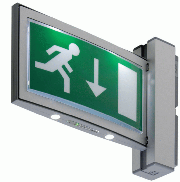 ICEL, the emergency lighting arm of the Lighting Industry Association (LIA), explains why compliance with the Fire Safety Order (FSO) is essential for users of affected premises.
ICEL, the emergency lighting arm of the Lighting Industry Association (LIA), explains why compliance with the Fire Safety Order (FSO) is essential for users of affected premises.
In the event of a fire, it is vital that premises owners and managers ensure that escape routes are properly illuminated in order to provide a fast and panic-free means of evacuation.
The role of emergency lighting is to make it easy for people evacuating a building to see clearly enough to safely and quickly make their way out, using the nearest and shortest designated exit routes. The Fire Safety Order (FSO) places considerable responsibility on owners and managers of non-domestic premises to demonstrate that their premises are safe. When a risk assessment shows the need for emergency lighting, such users must be able to demonstrate that appropriate equipment has been chosen and used to provide adequate light levels.
The guides to the FSO recommend that emergency lighting should be designed, installed and maintained to the guidance given in British Standard Code of Practice BS 5266-1, which calls for products used to meet their appropriate standards. It is essential therefore, that responsible building owners and managers can demonstrate compliance with this legislation.
Know your responsibilities
Many building owners and managers may be unsure of their obligations and as such, ICEL can offer advice and guidance including how to ensure compliance with the regulations, such as the FSO. ICEL advice (and approval of products and manufacturers in some cases) takes the risk out of specifying emergency lighting and ensures that the lighting performance of the luminaires has been independently confirmed. ICEL and BAFE – the non-profit making organisations dedicated to improving standards in fire protection – can assist such users with approved products and design information. Together, these organisations can assist designers, installers, maintainers and users by giving third party accreditation of their competence.
While many building owners and managers have taken ICEL advice to ensure that the emergency lighting systems in their premises comply with FSO requirements, there are many others that have not taken this course of action, and whose emergency lighting systems do not necessarily comply. Indeed, UK government statistics on Fire Safety Audits have estimated that around 40% of premises are likely to be unsatisfactory.
Are you at risk?
Lack of an emergency lighting system, use of an inadequate system or having a system without acceptable test records, means that such building owners and managers could be judged by FSO auditors as not being in accordance with the legislation. This could result in fines and/or prosecutions, but more importantly, it puts occupiers and users at potential risk if there was a need to evacuate the premises in an emergency.
Depending upon the seriousness of any such problem, the Fire Authorities have three courses of action. They can issue an enforcement notice detailing the changes needed and a time scale, they can issue a prohibition order that restricts use of the premises or, if the issue is serious, the Fire Authority will take action through the courts.
To avoid such actions by authorities and, more importantly, to protect occupants, building owners and managers must be able to demonstrate that their premises are safe, and that they meet the recommendations given in the guides to the FSO (particularly pages 3 – 8). These recommend that suppliers of services and equipment are third party certified to assist building owners and managers in demonstrating compliance to the fire authority.
Emergency lighting manufacturers belonging to ICEL are committed to produce equipment to the latest standards and provide information for it to be designed and installed to BS 5266-1, therefore assisting users in complying with the FSO.
Lighting Industry Federation (LIF)
T: 0207 793 3020






